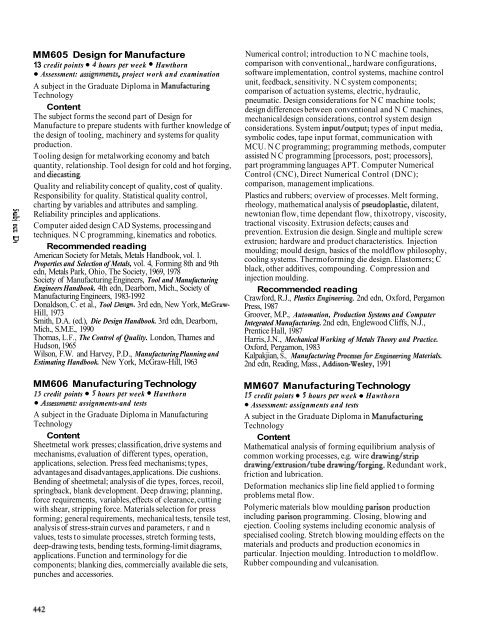1996 Swinburne Higher Education Handbook
1996 Swinburne Higher Education Handbook
1996 Swinburne Higher Education Handbook
You also want an ePaper? Increase the reach of your titles
YUMPU automatically turns print PDFs into web optimized ePapers that Google loves.
MM605 Design for Manufacture<br />
13 credit points 4 hours per week Hawthorn<br />
Assessment: assignments, project work and examination<br />
A subject in the Graduate Diploma in Manufacturing<br />
Technology<br />
Content<br />
The subject forms the second part of Design for<br />
Manufacture to prepare students with further knowledge of<br />
the design of tooling, machinery and systems for quality<br />
production.<br />
Tooling design for metalworking economy and batch<br />
quantity, relationship. Tool design for cold and hot forging,<br />
and diecasting.<br />
Quality and reliability concept of quality, cost of quality.<br />
Responsibility for quality. Statistical quality control,<br />
charting by variables and attributes and sampling.<br />
V)<br />
5 Reliability principles and applications.<br />
I;.<br />
8 Computer aided design CAD Systems, processing and<br />
F techniques. NC programming, kinematics and robotics.<br />
Recommended reading<br />
American Society for Metals, Metals <strong>Handbook</strong>, vol. 1.<br />
Properties and Selection of Metals, vol. 4, Forming 8th and 9th<br />
edn, Metals Park, Ohio, The Society, 1969, 1978<br />
Society of Manufacturing Engineers, Tool and Manufacturing<br />
Engineers <strong>Handbook</strong>. 4th edn, Dearborn, Mich., Society of<br />
Manufacturing Engineers, 1983-1992<br />
Donaldson, C. et al., Tool Desim. 3rd edn, New York, McGraw-<br />
Hill, 1973<br />
Smith, D.A. (ed.), Die Design <strong>Handbook</strong>. 3rd edn, Dearborn,<br />
Mich., S.M.E., 1990<br />
Thomas, L.F., The Control of Quality. London, Thames and<br />
Hudson, 1965<br />
Wilson, F.W. and Harvey, P.D., Manufacturing Planning and<br />
Estimating <strong>Handbook</strong>. New York, McGraw-Hill, 1963<br />
MM606 Manufacturing Technology<br />
15 credit points 5 hours per week Hawthorn<br />
~ssessment: assignments-and tests<br />
A subject in the Graduate Diploma in Manufacturing<br />
Technology<br />
Content<br />
Sheetmetal work presses; classification, drive systems and<br />
mechanisms, evaluation of different types, operation,<br />
applications, selection. Press feed mechanisms; types,<br />
advantages and disadvantages, applications. Die cushions.<br />
Bending of sheetmetal; analysis of die types, forces, recoil,<br />
springback, blank development. Deep drawing; planning,<br />
force requirements, variables, effects of clearance, cutting<br />
with shear, stripping force. Materials selection for press<br />
forming; general requirements, mechanical tests, tensile test,<br />
analysis of stress-strain curves and parameters, r and n<br />
values, tests to simulate processes, stretch forming tests,<br />
deep-drawing tests, bending tests, forming-limit diagrams,<br />
applications. Function and terminology for die<br />
components; blanking dies, commercially available die sets,<br />
punches and accessories.<br />
Numerical control; introduction to NC machine tools,<br />
comparison with conventional,, hardware configurations,<br />
software implementation, control systems, machine control<br />
unit, feedback, sensitivity. NC system components;<br />
comparison of actuation systems, electric, hydraulic,<br />
pneumatic. Design considerations for NC machine tools;<br />
design differences between conventional and N C machines,<br />
mechanical design considerations, control system design<br />
considerations. System input/output; types of input media,<br />
symbolic codes, tape input format, communication with<br />
MCU. NC programming; programming methods, computer<br />
assisted NC programming [processors, post; processors],<br />
part programming languages APT. Computer Numerical<br />
Control (CNC), Direct Numerical Control (DNC);<br />
comparison, management implications.<br />
Plastics and rubbers; overview of processes. Melt forming,<br />
rheology, mathematical analysis of pseudoplastic, dilatent,<br />
newtonian flow, time dependant flow, thixotropy, viscosity,<br />
tractional viscosity. Extrusion defects; causes and<br />
prevention. Extrusion die design. Single and multiple screw<br />
extrusion; hardware and product characteristics. Injection<br />
moulding; mould design, basics of the moldflow philosophy,<br />
cooling systems. Thermoforming die design. Elastomers; C<br />
black, other additives, compounding. Compression and<br />
injection moulding.<br />
Recommended reading<br />
Crawford, R.J., Plastics Enginem'ng. 2nd edn, Oxford, Pergamon<br />
Press, 1987<br />
Groover, M.P., Automation, Production Systems and Computer<br />
Integrated Manufacturing. 2nd edn, Englewood Cliffs, N.J.,<br />
Prentice Hall, 1987<br />
Harris, J.N., Mechanical Working of Metals Theory and Practice.<br />
Oxford, Pergamon, 1983<br />
Kalpakjian, S., Manufacturing Processesfor Enginewing Materials.<br />
2nd edn, Reading, Mass., Addison-Wesley, 1991<br />
MM607 Manufacturing Technology<br />
15 credit points 5 hours per week Hawthorn<br />
Assessment: assignments and tests<br />
A subject in the Graduate Diploma in Manufacturing<br />
Technology<br />
Content<br />
Mathematical analysis of forming equilibrium analysis of<br />
common working processes, e.g. wire drawing/strip<br />
drawing/extrusion/tube drawing/forging. Redundant work,<br />
friction and lubrication.<br />
Deformation mechanics slip line field applied to forming<br />
problems metal flow.<br />
Polymeric materials blow moulding parison production<br />
including parison programming. Closing, blowing and<br />
ejection. Cooling systems including economic analysis of<br />
specialised cooling. Stretch blowing moulding effects on the<br />
materials and products and production economics in<br />
particular. Injection moulding. Introduction to moldflow.<br />
Rubber compounding and vulcanisation.
















